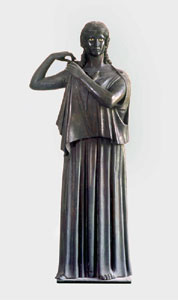Exhibition opens June 13 at the ROM
Some of its 200 remarkable objects appear for the first time outside of Italy
Casts of the victims of this natural disaster are among exhibition’s highlights

Girl fastening her peplos (Peplophoros)
1st century BC – 1st century AD
Bronze
Courtesy of the Trustees of the British Museum, with the permission of the Soprintendenza Speciale per Pompei, Ercolano e Stabia (SSPES)
(Toronto, Ontario – March 9, 2015) — The Royal Ontario Museum (ROM) presents the Canadian premiere of Pompeii: In the Shadow of the Volcano from Saturday, June 13, 2015 to Sunday, January 3, 2016. Displayed in the ROM’s Garfield Weston Exhibition Hall, Pompeii features approximately 200 artifacts that tell the dramatic story of an ancient city captured in time. Loaned by The Superintendence for Archaeological Heritage of Naples and the Soprintendenza Speciale di Pompei, Erocolano e Stabia, a number of objects have never before travelled outside Italy.
Nearly 2000 years ago—in Year 79—Mount Vesuvius, a long dormant volcano in southern Italy, erupted with great force. Within 24 hours, the city of Pompeii vanished under metres of ash and falling debris, remaining hidden for nearly 1,700 years—until archaeological excavations uncovered the city nearly intact.
THE ROM’S EXHIBITION
Visitors explore Pompeii and learn of its fate through the exhibition’s six distinctive sections. An Introductory experience underscores what we know about the city and the ancient Romans who lived and died there. Three key displays establish that the exhibition is about those people, the volcano that buried them, and the wealth of objects remarkably preserved by the destruction. The volcano Mount Vesuvius is introduced in this section, and remains a constant, menacing presence throughout the exhibition.
From the mid-18th century, extensive excavations of Pompeii provided unparalleled knowledge of ancient Roman life. The exhibition’s Out of the Ashes examines the rediscovery, establishing that, with its eruption, Mount Vesuvius transformed a relatively minor Roman city into one of the world’s most famous archaeological sites. Pompeii is a veritable “time capsule” of well-preserved artifacts, vividly informing on life in a typical small Roman city.
The citizens of Pompeii are the exhibition’s unique focus. The Living City features the greatest concentration of objects to explore the daily lives of its population. Public Life includes a pair of spectacular life-sized marble portrait statues of a young man and woman as well as exquisitely carved statues of Roman gods in marble and bronze. Gladiators’ equipment reveals a popular entertainment while tools and objects including coins and scales illuminate the city’s commercial activity. Domestic scenes are portrayed as the exhibition moves into Private Life. Villas lavishly decorated with large-scale wall paintings, intricate mosaics, and elegant furnishings; and exterior gardens embellished with spectacular sculptures beautifully demonstrate Pompeians’ taste for luxury. Stunning jewellery of gold and precious stones and luxurious silver dining ware are among this section’s highlights. Dishes holding carbonized figs and olives, about to be eaten at the moment disaster struck, are displayed here.
Time Runs out for Pompeii is the exhibition’s central dramatic moment. An immersive experience engulfs visitors as the disaster’s chronology is explained and visitors learn why the eruption was so catastrophic
The iconic Girl fastening her peplos (Peplophoros) is seen in this section. The life-sized, bronze statue, buried by the cataclysmic eruption, is a moving symbol of the vibrant city. “Her” presence is rendered more poignant by the inclusion of a survivor’s eyewitness account — one of history’s first-ever detailed scientific observation of a volcanic eruption—provided by the Roman author Pliny the Younger.
The Human Toll reveals the devastating loss of life resulting from the disaster. As the story of their archaeological discovery and preservation is told, visitors see casts of those who perished. These people, whose lives were similar to ours in many respects, reveal life’s fragility in the face of natural disaster.
Timed tickets for Pompeii: In the Shadow of the Volcano are now on sale at www.rom.on.ca/pompeii. The exhibition’s Members’ Preview takes place on Friday, June 12 from 10:00 am to 6:00 pm and Saturday, June 13 from 10:00 am to 12 noon.
Organized in partnership by the Royal Ontario Museum, Toronto and the Montreal Museum of Fine Arts, in collaboration with The Superintendence for the Archaeological Heritage of Naples and The Soprintendenza Speciale di Pompei, Ercolano e Stabia.

Wall painting depicting the distribution of bread
1st century BC - 1st century AD
Plaster
With permission of the Superintendence for the Archaeological Heritage of Naples (SAHN)

Free-blown jar imitating the form of a bronze vessel
1st century BC - 1st century AD
Glass
With permission of the Superintendence for the Archaeological Heritage of Naples (SAHN)

Bulla
1st century BC - 1st century AD
Gold
With permission of the Superintendence for the Archaeological Heritage of Naples (SAHN)
About the ROM
Opened in 1914, Canada’s largest museum of natural history and world cultures has six million objects in its collections and galleries showcasing art, archaeology and natural science. The ROM is the largest field research institution in the country, and a world leader in research areas from biodiversity, palaeontology, and earth sciences to archaeology, ethnology and visual culture - originating new information towards a global understanding of historical and modern change in culture and environment. For 24-hour information in English and French, please call 416.586.8000 or visit the ROM’s web site at www.rom.on.ca. Tickets are available online at www.rom.on.ca.
ROM SOCIAL MEDIA
Join the Conversation: #ROMPEII
Like: ROM Facebook
Follow: @ROMtoronto
ROM Instagram ROM Google+
Watch: ROM YouTube
Media Contact:
Marilynne Friedman, Senior Publicist: marilynf@rom.on.ca or 416.586.5826
